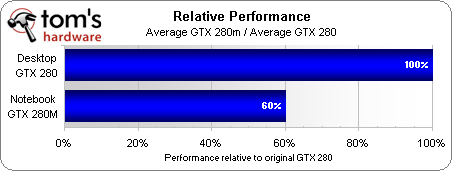Mobile GeForce GTX Graphics: Model Inflation Gone Awry
At Least Two Steps Too Far
Naming inflation is usually nothing more than an annoyance for those in the know. Our criticism of former examples, such as the 9600 XT-based Mobility 9700, is tempered by the understanding that the desktop part, though only slightly faster, wasn’t suitable for a notebook’s heat and power requirements. Nevertheless, this practice has seemingly spun out of control.
Even when this has happened on the desktop (remember back to when G92 transitioned from the 8800/9800 series to the GTS 250?) it drew only minor quibble, since the model number 250 didn’t imply parity to existing parts. But if renaming the GTX 8800 to GTS 250 after little more than a die shrink and clock increase went half a step beyond what most enthusiasts wanted to see, underclocking the same so-called GTS 250 part below desktop GeForce 8800 GTS 512-levels and raising its model number to that of last summer’s flagship is at least two steps—if not a giant leap—too far. Notebook buyers expecting the very best of last-year’s desktop performance from this year’s mobile parts will be stunned to find that their products don’t even live up to the specifications of 2007’s upper-mainstream graphics processor.
It’s a big difference. It’s the difference between being completely playable at a large-screen notebook’s native 1920x1200 resolution and not being at all playable even after dropping to a mid-market 1680x1050 setting. To put it in perspective, we made two handy charts that compare all resolutions for the average of tested games. Let’s consider the less-demanding tests first.
At our lower test settings, the GeForce GTX 280M is barely playable on average at 1280x1024. The notebook’s integrated panel did not support a similarly-demanding 1440x900 wide-screen resolution, so players must tolerate either a stretched image or reduced image size in addition to the grainier image, or make a big sacrifice in rendering quality.
Turning up the visual quality even more results in a mobile graphics machine that isn’t even playable at 1280x1024.
A performance loss of 40% compared to its namesake GeForce GTX 280 isn’t quite as bad as we expected for the GTX 280M, but it’s still enough to ruin the experience.
In spite of all our naming complaints, today’s notebook comparison proves the GeForce GTX 280M is indeed a top-performer as far as notebooks go. But being the fastest notebook gamer at a LAN full of desktops would be kind of like being the fattest fly in a jungle filled with frogs and spiders. The easiest point to take away from this is that if you really want a mobile gaming experience, you’re probably going to need a portable desktop.
Get Tom's Hardware's best news and in-depth reviews, straight to your inbox.
There’s really no excuse for Nvidia’s naming strategy here. It’s not like the company couldn’t have used the title GTS 250M for its mobile version and applied even lower model numbers to less-powerful models. But Nvidia is playing a game of relativity, we suppose. Just having a mobile GPU capable of beating the competitor's desktop-derived notebook solution is license enough to name its product as if it also came from its namesake's DNA.
Current page: At Least Two Steps Too Far
Prev Page Stalker: Clear Sky And World In Conflict Next Page Angelini: Taking ATI To Task, Too-
tacoslave and here i thought they were going to name it the gts 250m, but 280m? thats just lowReply -
Crashman IzzyCraftProbably not more then 30 mins But that's not the point.Reply
Actually, if you look at the notebook it's in...you could probably cool at least a GTX 275 with same-sized sinks if you had a lower power CPU. -
Sharft6 :o i never noticed this before although I've never had a laptop before. maybe this article could stoke up the the big boys in the gfx department to rethink their naming schemes :)Reply -
apache_lives will these parts crash and burn like every other previous nvidia product released for laptop over the last 2 years?Reply -
Crashman Reply9476634 said:Well, the laptop maker could always try putting in a normal Geforce card...
It would be hard, but when nVidia makes a card using the same specs as the GTS 250...except lower clock speeds...it could at least call the thing a GTS 250M.
Then again, both it an the GTS 250 are actually die-shrunk, underclocked 8800 GTS 512s...with twice the memory. -
falchard I think the die on the GTX 260+ is just too large to shrink down to be cool enough and power hungryless enough to put in a laptop.Reply



